Supported by the Mellon Foundation “Humanities for All Times” initiative.
Dr. Renzo Aroni: Indigenous Peasant Struggle in Peru’s Shining Path Insurgency, 1980-1992
Weis Cinema, Bard College Campus Center
Tuesday, April 18th, 6:00pm
Join Dr. Renzo Aroni for a quru guitarra performance and lecture on the Indigenous Peasant Struggle in Peru’s Shining Path Insurgency, 1980-1992.
Why did Indigenous peasants support but ultimately resist the Maoist Shining Path guerrilla group in highland Peruvian Quechua communities? The different ways rebels and government security forces interacted in each Andean community explain the diverse peasant responses. At first, the politics of pursuing social justice mobilized a large part of the rural population, especially the youths, who often sympathized with the Maoist revolution. The motivating factors in engaging with the insurgency in rural communities include local experiences of state neglect, social inequality, power relation, and fear and intimidation. Shining Path’s mounting authoritarianism, most notably their brutal killing of community authorities and demand that peasants withdraw from the market economy, explains the root of violent peasant uprisings against the rebels. The Indigenous struggle involved making the anti-guerrilla and pro-state coalition called the Pacto de Alianza entre Pueblos. It brought internal security and order, allowing Indigenous peasants to maintain daily life and protect their local affairs in wartime violence. The Pacto de Alianza was not limited to the counterinsurgency goals; its functions extended to the local governance, social cohesion, and post-conflict reconstruction.
